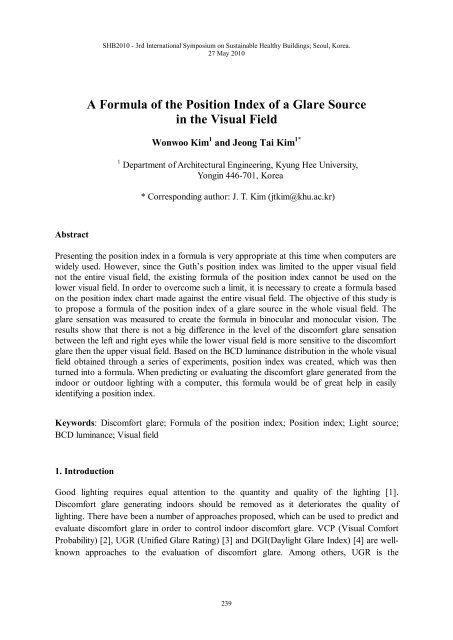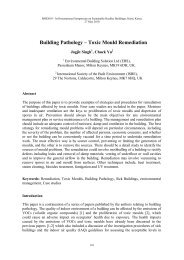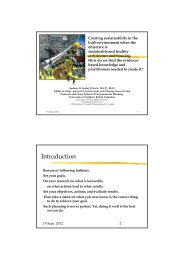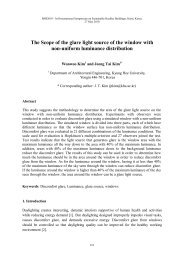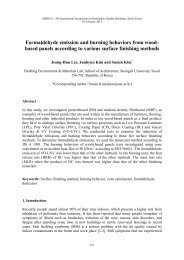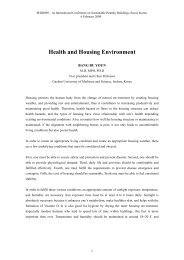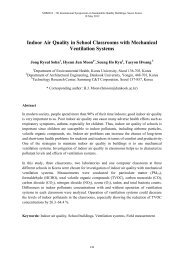A Formula of the Position Index of a Glare Source in the Visual Field
A Formula of the Position Index of a Glare Source in the Visual Field
A Formula of the Position Index of a Glare Source in the Visual Field
You also want an ePaper? Increase the reach of your titles
YUMPU automatically turns print PDFs into web optimized ePapers that Google loves.
Abstract<br />
A <strong>Formula</strong> <strong>of</strong> <strong>the</strong> <strong>Position</strong> <strong>Index</strong> <strong>of</strong> a <strong>Glare</strong> <strong>Source</strong><br />
<strong>in</strong> <strong>the</strong> <strong>Visual</strong> <strong>Field</strong><br />
Wonwoo Kim 1 and Jeong Tai Kim 1*<br />
1 Department <strong>of</strong> Architectural Eng<strong>in</strong>eer<strong>in</strong>g, Kyung Hee University,<br />
Yong<strong>in</strong> 446-701, Korea<br />
* Correspond<strong>in</strong>g author: J. T. Kim (jtkim@khu.ac.kr)<br />
Present<strong>in</strong>g <strong>the</strong> position <strong>in</strong>dex <strong>in</strong> a formula is very appropriate at this time when computers are<br />
widely used. However, s<strong>in</strong>ce <strong>the</strong> Guth’s position <strong>in</strong>dex was limited to <strong>the</strong> upper visual field<br />
not <strong>the</strong> entire visual field, <strong>the</strong> exist<strong>in</strong>g formula <strong>of</strong> <strong>the</strong> position <strong>in</strong>dex cannot be used on <strong>the</strong><br />
lower visual field. In order to overcome such a limit, it is necessary to create a formula based<br />
on <strong>the</strong> position <strong>in</strong>dex chart made aga<strong>in</strong>st <strong>the</strong> entire visual field. The objective <strong>of</strong> this study is<br />
to propose a formula <strong>of</strong> <strong>the</strong> position <strong>in</strong>dex <strong>of</strong> a glare source <strong>in</strong> <strong>the</strong> whole visual field. The<br />
glare sensation was measured to create <strong>the</strong> formula <strong>in</strong> b<strong>in</strong>ocular and monocular vision. The<br />
results show that <strong>the</strong>re is not a big difference <strong>in</strong> <strong>the</strong> level <strong>of</strong> <strong>the</strong> discomfort glare sensation<br />
between <strong>the</strong> left and right eyes while <strong>the</strong> lower visual field is more sensitive to <strong>the</strong> discomfort<br />
glare <strong>the</strong>n <strong>the</strong> upper visual field. Based on <strong>the</strong> BCD lum<strong>in</strong>ance distribution <strong>in</strong> <strong>the</strong> whole visual<br />
field obta<strong>in</strong>ed through a series <strong>of</strong> experiments, position <strong>in</strong>dex was created, which was <strong>the</strong>n<br />
turned <strong>in</strong>to a formula. When predict<strong>in</strong>g or evaluat<strong>in</strong>g <strong>the</strong> discomfort glare generated from <strong>the</strong><br />
<strong>in</strong>door or outdoor light<strong>in</strong>g with a computer, this formula would be <strong>of</strong> great help <strong>in</strong> easily<br />
identify<strong>in</strong>g a position <strong>in</strong>dex.<br />
Keywords: Discomfort glare; <strong>Formula</strong> <strong>of</strong> <strong>the</strong> position <strong>in</strong>dex; <strong>Position</strong> <strong>in</strong>dex; Light source;<br />
BCD lum<strong>in</strong>ance; <strong>Visual</strong> field<br />
1. Introduction<br />
SHB2010 - 3rd International Symposium on Susta<strong>in</strong>able Healthy Build<strong>in</strong>gs; Seoul, Korea.<br />
27 May 2010<br />
Good light<strong>in</strong>g requires equal attention to <strong>the</strong> quantity and quality <strong>of</strong> <strong>the</strong> light<strong>in</strong>g [1].<br />
Discomfort glare generat<strong>in</strong>g <strong>in</strong>doors should be removed as it deteriorates <strong>the</strong> quality <strong>of</strong><br />
light<strong>in</strong>g. There have been a number <strong>of</strong> approaches proposed, which can be used to predict and<br />
evaluate discomfort glare <strong>in</strong> order to control <strong>in</strong>door discomfort glare. VCP (<strong>Visual</strong> Comfort<br />
Probability) [2], UGR (Unified <strong>Glare</strong> Rat<strong>in</strong>g) [3] and DGI(Daylight <strong>Glare</strong> <strong>Index</strong>) [4] are wellknown<br />
approaches to <strong>the</strong> evaluation <strong>of</strong> discomfort glare. Among o<strong>the</strong>rs, UGR is <strong>the</strong><br />
239
SHB2010 - 3rd International Symposium on Susta<strong>in</strong>able Healthy Build<strong>in</strong>gs; Seoul, Korea.<br />
27 May 2010<br />
evaluation method that <strong>the</strong> International Commission on Illum<strong>in</strong>ation (CIE) def<strong>in</strong>ed as <strong>the</strong><br />
standard to evaluate discomfort glare.<br />
Exist<strong>in</strong>g methods quantify discomfort glare <strong>in</strong> l<strong>in</strong>e with <strong>the</strong> size <strong>of</strong> <strong>the</strong> four physical elements.<br />
Those four elements are lum<strong>in</strong>ance and size <strong>of</strong> <strong>the</strong> glare source, background lum<strong>in</strong>ance and its<br />
location <strong>in</strong> <strong>the</strong> visual field [5]. The location element <strong>of</strong> <strong>the</strong> glare source <strong>in</strong> <strong>the</strong> visual field is<br />
used <strong>in</strong> order to adjust <strong>the</strong> change <strong>in</strong> <strong>the</strong> discomfort glare from <strong>the</strong> source deviat<strong>in</strong>g from <strong>the</strong><br />
l<strong>in</strong>e <strong>of</strong> sight [6]. Although <strong>the</strong> light source has <strong>the</strong> same lum<strong>in</strong>ance and size, <strong>the</strong> light source<br />
located closer to <strong>the</strong> l<strong>in</strong>e <strong>of</strong> sight feels brighter than <strong>the</strong> one located far<strong>the</strong>r away from <strong>the</strong> l<strong>in</strong>e<br />
<strong>of</strong> sight. Such phenomenon is well shown <strong>in</strong> <strong>the</strong> glare experiments conducted by Luckiesh and<br />
Holladay [7].<br />
In 1925, Luckiesh and Holladay compared <strong>the</strong> discomfort glare from light source by chang<strong>in</strong>g<br />
its location vertically from <strong>the</strong> l<strong>in</strong>e <strong>of</strong> sight. They found that <strong>the</strong> far<strong>the</strong>r <strong>the</strong> light source moves<br />
from <strong>the</strong> l<strong>in</strong>e <strong>of</strong> sight, <strong>the</strong> brighter <strong>the</strong> light source should get <strong>in</strong> order to create <strong>the</strong> same level<br />
<strong>of</strong> glare sensation. This is because <strong>of</strong> <strong>the</strong> fact that <strong>the</strong> location <strong>of</strong> <strong>the</strong> light source changes<br />
with<strong>in</strong> <strong>the</strong> visual field. This experiment was conducted by mak<strong>in</strong>g movement <strong>in</strong> <strong>the</strong> vertical<br />
direction only. The current light<strong>in</strong>g environment reveals that <strong>the</strong> light<strong>in</strong>g equipment is<br />
presented not only <strong>in</strong> <strong>the</strong> upper visual field but also <strong>in</strong> <strong>the</strong> lower visual field. Therefore it is<br />
necessary to review <strong>the</strong> glare sensation for <strong>the</strong> entire visual field.<br />
In 1949, Guth measured Borderl<strong>in</strong>e between Comfort and Discomfort (BCD) lum<strong>in</strong>ance by<br />
locat<strong>in</strong>g a number <strong>of</strong> light sources <strong>in</strong> <strong>the</strong> upper visual field [6]. As a result, <strong>the</strong>y found that <strong>the</strong><br />
far<strong>the</strong>r <strong>the</strong> light source gets from <strong>the</strong> l<strong>in</strong>e <strong>of</strong> sight, <strong>the</strong> higher <strong>the</strong> lum<strong>in</strong>ance <strong>of</strong> BCD. This<br />
experiment was, however, conf<strong>in</strong>ed to <strong>the</strong> upper visual field only.<br />
<strong>Position</strong> <strong>in</strong>dex <strong>of</strong> <strong>the</strong> glare source suggested by Guth is shown <strong>in</strong> <strong>the</strong> chart [6]. However, <strong>in</strong><br />
<strong>the</strong> VCP, <strong>the</strong> chart has been converted <strong>in</strong>to numerical formula <strong>in</strong> order to express <strong>the</strong> position<br />
<strong>in</strong>dex <strong>in</strong> a way much easier to understand [8]. Present<strong>in</strong>g <strong>the</strong> position <strong>in</strong>dex <strong>in</strong> a formula is<br />
very appropriate at this time when computers are widely used. However, s<strong>in</strong>ce <strong>the</strong> Guth’s<br />
position <strong>in</strong>dex was limited to <strong>the</strong> upper visual field not <strong>the</strong> entire visual field, <strong>the</strong> position <strong>in</strong>dex<br />
used <strong>in</strong> VCP can be used only for <strong>the</strong> upper visual field. In o<strong>the</strong>r words, this formula cannot be<br />
used on <strong>the</strong> lower visual field. In order to overcome such a limit, it is necessary to create a<br />
formula based on <strong>the</strong> position <strong>in</strong>dex chart made aga<strong>in</strong>st <strong>the</strong> entire visual field.<br />
The purpose <strong>of</strong> this study is to create a position <strong>in</strong>dex chart by measur<strong>in</strong>g <strong>the</strong> distribution <strong>of</strong><br />
<strong>the</strong> glare sensation across <strong>the</strong> entire visual field and turn it <strong>in</strong>to a formula.<br />
240
2. <strong>Position</strong> <strong>Index</strong> <strong>of</strong> a glare source<br />
The position <strong>in</strong>dex used <strong>in</strong> <strong>the</strong> VCP is what Guth suggested <strong>in</strong> 1949. Guth’s position <strong>in</strong>dex<br />
was created based on <strong>the</strong> measurements made with 50 subjects aged from 20 to 40. The<br />
devices used for <strong>the</strong> measurement <strong>in</strong>cluded a sphere 1/3 <strong>of</strong> which was cut out and whose<br />
diameter is about 203cm, a lamp <strong>in</strong>side <strong>the</strong> sphere which created <strong>the</strong> background lum<strong>in</strong>ance,<br />
and basel<strong>in</strong>e and control light sources.<br />
The subject was requested to look at <strong>the</strong> basel<strong>in</strong>e light source located on <strong>the</strong> l<strong>in</strong>e <strong>of</strong> sight and<br />
to determ<strong>in</strong>e a BCD (Borderl<strong>in</strong>e Between Comfort and Discomfort) lum<strong>in</strong>ance, which was<br />
def<strong>in</strong>ed as <strong>the</strong> basel<strong>in</strong>e lum<strong>in</strong>ance on which <strong>the</strong> position <strong>in</strong>dex is to be created. After locat<strong>in</strong>g<br />
<strong>the</strong> test light source on a spot not on <strong>the</strong> l<strong>in</strong>e <strong>of</strong> sight, <strong>the</strong> subject was asked to <strong>in</strong>dicate a<br />
moment when he or she felt that <strong>the</strong> basel<strong>in</strong>e light source on <strong>the</strong> l<strong>in</strong>e <strong>of</strong> sight had <strong>the</strong> same<br />
lum<strong>in</strong>ance with <strong>the</strong> test light source. Such brightness <strong>of</strong> <strong>the</strong> test light source was def<strong>in</strong>ed as <strong>the</strong><br />
BCD lum<strong>in</strong>ance at <strong>the</strong> location <strong>of</strong> <strong>the</strong> test light source. The light source used was 0.0011sr and<br />
<strong>the</strong> lum<strong>in</strong>ance <strong>of</strong> <strong>the</strong> <strong>in</strong>terior surface <strong>of</strong> <strong>the</strong> sphere was uniform at 34cd/㎡.<br />
In <strong>the</strong> experiment, <strong>the</strong> test light source was placed at an <strong>in</strong>terval <strong>of</strong> 10˚ vertically from <strong>the</strong><br />
l<strong>in</strong>e <strong>of</strong> sight (azimuth 90˚ ), diagonally (azimuth45˚ ), horizontally (azimuth 0˚ ) over <strong>the</strong><br />
upper visual field <strong>in</strong> order to measure <strong>the</strong> BCD lum<strong>in</strong>ances. Today’s light<strong>in</strong>g environment has<br />
light<strong>in</strong>g equipment found <strong>in</strong> <strong>the</strong> lower visual field, so fail<strong>in</strong>g to measure <strong>the</strong> BCD lum<strong>in</strong>ance on<br />
<strong>the</strong> lower visual field is a critical shortcom<strong>in</strong>g.<br />
The position <strong>in</strong>dex created from <strong>the</strong> Guth’s experiment can be expressed as follows <strong>in</strong> <strong>Formula</strong><br />
1 [8].<br />
[<strong>Formula</strong> 1]<br />
SHB2010 - 3rd International Symposium on Susta<strong>in</strong>able Healthy Build<strong>in</strong>gs; Seoul, Korea.<br />
27 May 2010<br />
Where = angle from vertical <strong>of</strong> <strong>the</strong> plane conta<strong>in</strong><strong>in</strong>g <strong>the</strong> source and <strong>the</strong> l<strong>in</strong>e <strong>of</strong> sight <strong>in</strong><br />
degrees, = angle between <strong>the</strong> l<strong>in</strong>e <strong>of</strong> sight and <strong>the</strong> l<strong>in</strong>e from <strong>the</strong> observer to <strong>the</strong> source.<br />
S<strong>in</strong>ce <strong>the</strong> position <strong>in</strong>dex <strong>of</strong> <strong>the</strong> upper and lower visual fields are not <strong>in</strong> symmetry [9, 10, 11],<br />
<strong>Formula</strong> 1 can be used for <strong>the</strong> upper visual field only. In order to evaluate discomfort glare<br />
generated from a light source no matter where <strong>the</strong> glare source is located on <strong>the</strong> visual field,<br />
position <strong>in</strong>dex formula that can be applied to <strong>the</strong> lower visual field is required.<br />
241<br />
--
3. Study Approach<br />
SHB2010 - 3rd International Symposium on Susta<strong>in</strong>able Healthy Build<strong>in</strong>gs; Seoul, Korea.<br />
27 May 2010<br />
First and foremost, <strong>the</strong> difference <strong>in</strong> <strong>the</strong> discomfort glare sensation between us<strong>in</strong>g one eye and<br />
both eyes was studied along with <strong>the</strong> difference <strong>in</strong> discomfort glare sensation between <strong>the</strong> up,<br />
down, left and right visual field. This exam<strong>in</strong>ation was required <strong>in</strong> order to create accurate<br />
position <strong>in</strong>dices. Then, position <strong>in</strong>dex chart was created based on <strong>the</strong> discomfort glare<br />
sensation <strong>of</strong> both eyes, which were to be f<strong>in</strong>ally expressed <strong>in</strong> <strong>the</strong> form <strong>of</strong> <strong>the</strong> position <strong>in</strong>dex<br />
formula.<br />
3.1. Devices for Experiment<br />
The glare tester was created for this study (Fig. 1). The glare tester was <strong>in</strong>stalled <strong>in</strong>side a lab<br />
where no light was allowed to come <strong>in</strong> from outside as all its w<strong>in</strong>dows were completely sealed<br />
<strong>of</strong>f. The temperature <strong>of</strong> <strong>the</strong> lab was ma<strong>in</strong>ta<strong>in</strong>ed at 26 degrees. The glare tester consisted <strong>of</strong> a<br />
semi-sphere dome with a diameter <strong>of</strong> 2 m, a semi-sphere shaped rail <strong>in</strong>side <strong>the</strong> dome, an<br />
<strong>in</strong>candescent lamp (100 W), and a halogen lamp (100 W). The semi-sphere shaped rail could<br />
rotate 360° and all <strong>the</strong> lamps were connected with <strong>the</strong> dimmer, so <strong>the</strong>ir lum<strong>in</strong>ance could be<br />
controlled.<br />
Test light source could be located on any spot with<strong>in</strong> <strong>the</strong> scope <strong>of</strong> <strong>the</strong> visual field. For this end,<br />
two test resources were mounted on <strong>the</strong> rail and <strong>the</strong>y were moved at <strong>the</strong> speed <strong>of</strong> 5<br />
degrees/sec by a power motor. The test light sources were connected with a timer so that <strong>the</strong><br />
time to turn on and <strong>of</strong>f <strong>the</strong> light could be controlled.<br />
The <strong>in</strong>terior <strong>of</strong> <strong>the</strong> semi-sphere dome was pa<strong>in</strong>ted white. The background lum<strong>in</strong>ance was<br />
adjustable <strong>in</strong> <strong>the</strong> range <strong>of</strong> 0~350 cd/m 2 . It was 0.0011 sr <strong>of</strong> <strong>the</strong> test light source and <strong>the</strong><br />
lum<strong>in</strong>ance was adjustable <strong>in</strong> <strong>the</strong> range <strong>of</strong> 0~160,000 cd/m 2 .<br />
Fig. 1. <strong>Glare</strong> Tester<br />
242
SHB2010 - 3rd International Symposium on Susta<strong>in</strong>able Healthy Build<strong>in</strong>gs; Seoul, Korea.<br />
27 May 2010<br />
3.2 How to Conduct <strong>the</strong> Experiment<br />
The experiment consisted <strong>of</strong> <strong>the</strong> three parts: part 1 measured <strong>the</strong> limits <strong>of</strong> <strong>the</strong> visual field <strong>of</strong> <strong>the</strong><br />
right and left and both eyes. Part 2 evaluated <strong>the</strong> BCD lum<strong>in</strong>ance <strong>of</strong> <strong>the</strong> entire visual field<br />
while part 3 assessed <strong>the</strong> BCD lum<strong>in</strong>ance on <strong>the</strong> l<strong>in</strong>e <strong>of</strong> sight.<br />
Prior to experiment, all <strong>the</strong> subjects were fully expla<strong>in</strong>ed <strong>of</strong> <strong>the</strong> limits <strong>of</strong> <strong>the</strong> visual field,<br />
concept <strong>of</strong> <strong>the</strong> BCD lum<strong>in</strong>ance along with <strong>the</strong> experiment procedures and approaches.<br />
Exercises were fully conducted. The dimmer was adjusted to set <strong>the</strong> background lum<strong>in</strong>ance <strong>of</strong><br />
<strong>the</strong> <strong>in</strong>terior <strong>of</strong> <strong>the</strong> dome at 34 cd/m 2 . Such background lum<strong>in</strong>ance was <strong>the</strong> same with <strong>the</strong> one<br />
applied <strong>in</strong> <strong>the</strong> Guth’s experiment. As <strong>the</strong> background lum<strong>in</strong>ance was set, <strong>the</strong> subject was asked<br />
to sit <strong>in</strong> a designated seat <strong>in</strong> front <strong>of</strong> <strong>the</strong> glare tester and <strong>the</strong>n asked put <strong>the</strong> jaw on jaw holder<br />
to focus <strong>the</strong> l<strong>in</strong>e <strong>of</strong> sight on <strong>the</strong> center <strong>of</strong> <strong>the</strong> screen.<br />
For <strong>the</strong> experiment part 1, when <strong>the</strong> visual field limits were measured <strong>the</strong> lum<strong>in</strong>ance <strong>of</strong> <strong>the</strong> test<br />
light source was set at 1,000 cd/m 2 . The visual field limits were measured at <strong>the</strong> azimuths <strong>of</strong><br />
0°, 45°, 90°, 135°, 180°, − 45°, − 90°, and − 135° (Fig. 2). On each <strong>of</strong> <strong>the</strong> azimuths<br />
chosen, <strong>the</strong> test light source was moved start<strong>in</strong>g from <strong>the</strong> location where it was 110° away<br />
from <strong>the</strong> l<strong>in</strong>e <strong>of</strong> sight towards <strong>the</strong> l<strong>in</strong>e <strong>of</strong> sight. While <strong>the</strong> test light source was mov<strong>in</strong>g, <strong>the</strong><br />
subject shouted ‘ Stop’ when <strong>the</strong> test light source came with<strong>in</strong> <strong>the</strong> visual field. Upon<br />
hear<strong>in</strong>g <strong>the</strong> shout, <strong>the</strong> experimenter stopped <strong>the</strong> test light source to record <strong>the</strong> angle distance<br />
from <strong>the</strong> azimuth. Azimuths were selected randomly by <strong>the</strong> experimenter. The same<br />
experiment was conducted three times per subject to measure <strong>the</strong> average, which was to be<br />
used as <strong>the</strong> data for analysis.<br />
In <strong>the</strong> experiment part 2 where <strong>the</strong> BCD lum<strong>in</strong>ance <strong>of</strong> <strong>the</strong> entire visual field was measured, <strong>the</strong><br />
test light source’s lum<strong>in</strong>ance was set at 3,000 cd/m 2 , 5,000 cd/m 2 , 10,000 cd/m 2 , and 30,000<br />
cd/m 2 . Table 1 shows <strong>the</strong> four types <strong>of</strong> test light sources used for <strong>the</strong> experiment. A total <strong>of</strong> 16<br />
spots <strong>of</strong> azimuths were selected: 0°, 22.5°, 45°, 67.5°, 90°, 112.5°, 135°, 157.5°, 180°, −<br />
22.5°, − 45°, − 67.5°, − 90°, − 112.5°, − 135°, and − 157°. On each <strong>of</strong> <strong>the</strong> azimuths<br />
chosen, <strong>the</strong> test light source was moved start<strong>in</strong>g from <strong>the</strong> location where it was 110° away<br />
from <strong>the</strong> l<strong>in</strong>e <strong>of</strong> sight towards <strong>the</strong> <strong>in</strong>side <strong>of</strong> <strong>the</strong> dome. As it was <strong>the</strong> case for <strong>the</strong> evaluation <strong>of</strong><br />
<strong>the</strong> visual field limits, <strong>the</strong> subject shouted ‘ Stop’ when <strong>the</strong> subject sensed BCD <strong>of</strong> <strong>the</strong> test<br />
light source. Upon hear<strong>in</strong>g <strong>the</strong> shout, <strong>the</strong> experimenter stopped <strong>the</strong> test light source to record<br />
<strong>the</strong> angle distance from <strong>the</strong> azimuth. Azimuths were selected randomly by <strong>the</strong> experimenter.<br />
The subject was exposed to <strong>the</strong> test light source start<strong>in</strong>g with higher lum<strong>in</strong>ance to <strong>the</strong> lower<br />
ones. The sequence was planned that way as it was expected that <strong>the</strong> light source with <strong>the</strong><br />
higher lum<strong>in</strong>ance would be stopped at <strong>the</strong> spot far<strong>the</strong>r from <strong>the</strong> l<strong>in</strong>e <strong>of</strong> sight compared with <strong>the</strong><br />
light source with lower lum<strong>in</strong>ance. This sequence was also designed <strong>in</strong> order to m<strong>in</strong>imize <strong>the</strong><br />
243
SHB2010 - 3rd International Symposium on Susta<strong>in</strong>able Healthy Build<strong>in</strong>gs; Seoul, Korea.<br />
27 May 2010<br />
case when <strong>the</strong> light source passed <strong>the</strong> center <strong>of</strong> <strong>the</strong> visual field dur<strong>in</strong>g experiment. For <strong>the</strong><br />
same subject, BCD lum<strong>in</strong>ance was measured for <strong>the</strong> left, right and both eyes for three times.<br />
In <strong>the</strong> experiment part 3 where <strong>the</strong> BCD lum<strong>in</strong>ance was measured on <strong>the</strong> l<strong>in</strong>e <strong>of</strong> sight, <strong>the</strong> test<br />
light source was placed at <strong>the</strong> center <strong>of</strong> <strong>the</strong> dome and <strong>the</strong> experimenter used a dimmer to<br />
gradually <strong>in</strong>crease <strong>the</strong> lum<strong>in</strong>ance. In this test, <strong>the</strong> test light source was set to automatically<br />
bl<strong>in</strong>k every second. When <strong>the</strong> subject shouted ‘ Stop’ upon feel<strong>in</strong>g BCD sensation <strong>of</strong> <strong>the</strong><br />
test light source, <strong>the</strong> experimenter recorded test light source’s lum<strong>in</strong>ance. For <strong>the</strong> same subject,<br />
BCD lum<strong>in</strong>ance was measured for <strong>the</strong> left, right and both eyes for three times<br />
The total time consumed to conduct <strong>the</strong> three experiments per subject was around 4 hours and<br />
30 m<strong>in</strong>utes. Measurement was done for 20 m<strong>in</strong>utes followed by a 10-m<strong>in</strong>ute break. Depend<strong>in</strong>g<br />
on how tired <strong>the</strong> subject felt <strong>in</strong> <strong>the</strong> eyes, experiments were conducted for at least twice or at<br />
<strong>the</strong> maximum four times over <strong>the</strong> period <strong>of</strong> 2~3 days. Experiment part 1 consisted <strong>of</strong> 24<br />
conditions, while part 2 had 192 and part 3 had 9 conditions respectively total<strong>in</strong>g 225.<br />
The subjects were graduate students or researchers who studied construction environment. A<br />
total <strong>of</strong> 8 subjects jo<strong>in</strong>ed <strong>the</strong> experiment: 4 males and 4 females. They aged from 20 to 31 with<br />
<strong>the</strong> average be<strong>in</strong>g 25.4 years old.<br />
157.5<br />
180<br />
-157.5<br />
135<br />
-135<br />
112.5<br />
-112.5<br />
Angular distance [°]<br />
100<br />
90<br />
80<br />
70<br />
60<br />
50<br />
40<br />
30<br />
20<br />
10<br />
0<br />
90<br />
-90<br />
67.5 Radial angle [°]<br />
L<strong>in</strong>e <strong>of</strong> sight<br />
-67.5<br />
45<br />
-45<br />
22.5<br />
0<br />
-22.5<br />
Fig. 2. Angular Distance and Radial Angle <strong>in</strong> <strong>the</strong> <strong>Visual</strong> <strong>Field</strong><br />
Table 1. Conditions <strong>of</strong> <strong>the</strong> Test Light <strong>Source</strong><br />
244
Test sources Lum<strong>in</strong>ance <strong>of</strong><br />
glare source L<br />
[cd/m 2 ]<br />
Size <strong>of</strong> glare<br />
<strong>Source</strong> ω<br />
[sr]<br />
I 3000 0.0011 34<br />
II 5000 0.0011 34<br />
III 10000 0.0011 34<br />
IV 30000 0.0011 34<br />
4. Results <strong>of</strong> Experiments and Observations<br />
4.1. <strong>Visual</strong> field limits<br />
SHB2010 - 3rd International Symposium on Susta<strong>in</strong>able Healthy Build<strong>in</strong>gs; Seoul, Korea.<br />
27 May 2010<br />
Background<br />
Lum<strong>in</strong>ance Lb<br />
[cd/m 2 ]<br />
Fig. 3 shows <strong>the</strong> visual field limits measured with left, right and both eyes (Experiment part 1).<br />
Upper visual fields <strong>of</strong> <strong>the</strong> left, right and both eyes were 1.52 sr, 1.54 sr and 2.03sr each while<br />
lower visual fields were 2.04 sr, 1.88 sr and 2.58 sr respectively. The whole visual fields <strong>of</strong> <strong>the</strong><br />
left, right and both eyes were 3.56 sr, 3.42 sr, 4.61 sr and <strong>the</strong> area where <strong>the</strong> left and right eye<br />
was overlapped was about 2.37 sr.<br />
The total <strong>of</strong> <strong>the</strong> visual field limits <strong>of</strong> left eye and right eye was similar to that <strong>of</strong> <strong>the</strong> visual field<br />
limits <strong>of</strong> both eyes. On <strong>the</strong> whole visual field, <strong>the</strong> left eye was 77.2% while <strong>the</strong> right eye was<br />
74.2%. On <strong>the</strong> whole visual field, <strong>the</strong> area where <strong>the</strong> left and right eye was overlapped was<br />
about 53.8%. The size <strong>of</strong> <strong>the</strong> whole visual field <strong>of</strong> both eyes was 4.61 sr. In addition, <strong>the</strong><br />
visual field limits <strong>of</strong> <strong>the</strong> left and right eyes were <strong>in</strong> symmetry.<br />
As for <strong>the</strong> upper visual field <strong>of</strong> both eyes, visual field limits were presented at <strong>the</strong> angle<br />
distance <strong>of</strong> about 53˚ when <strong>the</strong> azimuth was 90˚ . The lower visual field was found to have<br />
an angle distance <strong>of</strong> about 67˚ when <strong>the</strong> azimuth was − 90˚ . The lower visual field<br />
appeared to be wider than <strong>the</strong> upper visual field.<br />
245
SHB2010 - 3rd International Symposium on Susta<strong>in</strong>able Healthy Build<strong>in</strong>gs; Seoul, Korea.<br />
27 May 2010<br />
Fig. 3. <strong>Visual</strong> <strong>Field</strong> Limits <strong>of</strong> S<strong>in</strong>gle and Both Eyes<br />
4.2 BCD lum<strong>in</strong>ance <strong>of</strong> <strong>the</strong> whole visual field<br />
Fig. 4, 5, 6,7 are <strong>the</strong> charts <strong>in</strong>dicat<strong>in</strong>g <strong>the</strong> locations on <strong>the</strong> visual field <strong>of</strong> <strong>the</strong> right and left and<br />
both eyes that had <strong>the</strong> same BCD lum<strong>in</strong>ance. The sizes <strong>of</strong> <strong>the</strong> BCD curves measured us<strong>in</strong>g <strong>the</strong><br />
test light source I (3,000 cd/m 2 ) were 0.14 sr, 0.14 sr and 0.22 sr on <strong>the</strong> upper visual field <strong>of</strong><br />
<strong>the</strong> right and left and both eyes respectively. They were 0.22 sr, 0.20 sr and 0.38 sr on <strong>the</strong><br />
lower visual field. The whole visual field <strong>of</strong> <strong>the</strong> right and left and both eyes was 0.36 sr, 0.34<br />
sr, and 0.60 sr while <strong>the</strong> area where <strong>the</strong> left and right eye was overlapped was approximately<br />
0.28 sr.<br />
The sizes <strong>of</strong> <strong>the</strong> BCD curves measured us<strong>in</strong>g <strong>the</strong> test light source II (5,000 cd/m 2 ) were 0.28<br />
sr, 0.27 sr and 0.37 sr on <strong>the</strong> upper visual field <strong>of</strong> <strong>the</strong> right and left and both eyes respectively.<br />
They were 0.45 sr, 0.47 sr and 0.65 sr on <strong>the</strong> lower visual field. The whole visual field <strong>of</strong> <strong>the</strong><br />
right and left and both eyes was 0.73 sr, 0.74 sr, 1.02 sr each, and <strong>the</strong> area where <strong>the</strong> left and<br />
right eye was overlapped was approximately 0.57 sr.<br />
The sizes <strong>of</strong> <strong>the</strong> BCD curves measured us<strong>in</strong>g <strong>the</strong> test light source III (10,000 cd/m 2 ) were 0.65<br />
sr, 0.61 sr and 0.77 sr on <strong>the</strong> upper visual field <strong>of</strong> <strong>the</strong> right and left and both eyes respectively.<br />
They were 1.08 sr, 0.95 sr and 1.28 sr on <strong>the</strong> lower visual field. The whole visual field <strong>of</strong> <strong>the</strong><br />
right and left and both eyes was 1.73 sr, 1.55 sr, 2.05 sr each, and <strong>the</strong> area where <strong>the</strong> left and<br />
right eye was overlapped was approximately 1.27 sr.<br />
246
SHB2010 - 3rd International Symposium on Susta<strong>in</strong>able Healthy Build<strong>in</strong>gs; Seoul, Korea.<br />
27 May 2010<br />
The sizes <strong>of</strong> <strong>the</strong> BCD curves measured us<strong>in</strong>g <strong>the</strong> test light source IV (30,000 cd/m 2 ) were 0.78<br />
sr, 0.66 sr and 0.92 sr on <strong>the</strong> upper visual field <strong>of</strong> <strong>the</strong> right and left and both eyes respectively.<br />
They were 1.53 sr, 1.39 sr and 1.75 sr on <strong>the</strong> lower visual field. The whole visual field <strong>of</strong> <strong>the</strong><br />
right and left and both eyes was 2.31 sr, 2.05 sr, 2.67 sr each, and <strong>the</strong> area where <strong>the</strong> left and<br />
right eye was overlapped was approximately 1.58 sr.<br />
Comb<strong>in</strong><strong>in</strong>g all <strong>the</strong> <strong>in</strong>formation on Fig. 4, 5, 6, 7 revealed <strong>the</strong> three important f<strong>in</strong>d<strong>in</strong>gs. First, on<br />
<strong>the</strong> visual field <strong>of</strong> <strong>the</strong> right and left and both eyes, <strong>the</strong> higher <strong>the</strong> test light source’s lum<strong>in</strong>ance,<br />
<strong>the</strong> bigger <strong>the</strong> BCD curve. This <strong>in</strong>dicates that BCD lum<strong>in</strong>ance was higher on <strong>the</strong> periphery<br />
than on <strong>the</strong> center <strong>of</strong> a visual field.<br />
Second, <strong>the</strong> size <strong>of</strong> <strong>the</strong> BCD curve <strong>of</strong> both eyes was <strong>the</strong> same with that <strong>of</strong> <strong>the</strong> BCD curve <strong>of</strong><br />
<strong>the</strong> left eye on <strong>the</strong> visual field <strong>of</strong> <strong>the</strong> left eye. It was also same with that <strong>of</strong> <strong>the</strong> BCD curve <strong>of</strong><br />
<strong>the</strong> right eye on <strong>the</strong> visual field <strong>of</strong> <strong>the</strong> right eye. This <strong>in</strong>dicates that on <strong>the</strong> left visual field, <strong>the</strong><br />
left eye reached <strong>the</strong> BCD sensation earlier, while it was <strong>the</strong> right eye that did so on <strong>the</strong> right<br />
visual field.<br />
Third, <strong>the</strong> BCD curves <strong>of</strong> <strong>the</strong> left and right eyes were <strong>in</strong> symmetry and <strong>the</strong> lower visual field<br />
had a wider BCD curve than <strong>the</strong> upper visual field. This <strong>in</strong>dicates that <strong>the</strong>re was not a big<br />
difference <strong>in</strong> <strong>the</strong> level <strong>of</strong> <strong>the</strong> discomfort glare sensation <strong>of</strong> <strong>the</strong> left and right eyes while <strong>the</strong><br />
lower visual field was more sensitive to <strong>the</strong> discomfort glare <strong>the</strong>n <strong>the</strong> upper visual field.<br />
Fig. 4 BCD Curves Measured Us<strong>in</strong>g <strong>the</strong> Test Light <strong>Source</strong> I (3,000 cd/m 2 )<br />
247
SHB2010 - 3rd International Symposium on Susta<strong>in</strong>able Healthy Build<strong>in</strong>gs; Seoul, Korea.<br />
27 May 2010<br />
Fig. 5. BCD Curves Measured Us<strong>in</strong>g <strong>the</strong> Test Light <strong>Source</strong> II (5,000 cd/m 2 )<br />
Fig. 6. BCD Curves Measured Us<strong>in</strong>g <strong>the</strong> Test Light <strong>Source</strong> III (10,000 cd/m 2 )<br />
Fig. 7. BCD Curves Measured Us<strong>in</strong>g <strong>the</strong> Test Light <strong>Source</strong> IV (30,000 cd/m 2 )<br />
248
4.3 BCD lum<strong>in</strong>ance on <strong>the</strong> l<strong>in</strong>e <strong>of</strong> sight<br />
Table 2 shows <strong>the</strong> BCD lum<strong>in</strong>ance <strong>of</strong> <strong>the</strong> test light source located on <strong>the</strong> l<strong>in</strong>e <strong>of</strong> sight. The<br />
average <strong>of</strong> <strong>the</strong> BCD lum<strong>in</strong>ance values measured on <strong>the</strong> l<strong>in</strong>e <strong>of</strong> sight was 3337 cd/m 2 for <strong>the</strong><br />
left eye, 4481 cd/m 2 for <strong>the</strong> right eye, and 5253 cd/m 2 for both eyes. In o<strong>the</strong>r words, <strong>the</strong> BCD<br />
lum<strong>in</strong>ance <strong>of</strong> <strong>the</strong> both eyes was 1.6 time higher than <strong>the</strong> average BCD lum<strong>in</strong>ance <strong>of</strong> <strong>the</strong> left<br />
eye, and 1.2 time higher than <strong>the</strong> average BCD lum<strong>in</strong>ance <strong>of</strong> <strong>the</strong> right eye.<br />
BCD lum<strong>in</strong>ance <strong>of</strong> both eyes was 1.9 time higher than what was found <strong>in</strong> <strong>the</strong> Guth’s<br />
experiment (about 2844 cd/m 2 on <strong>the</strong> average). These results <strong>in</strong>dicate that <strong>the</strong> BCD lum<strong>in</strong>ance<br />
<strong>of</strong> Koreans was higher than <strong>the</strong> BCD lum<strong>in</strong>ance <strong>in</strong> Guth’s experiment.<br />
Table 2. BCD Lum<strong>in</strong>ance on <strong>the</strong> L<strong>in</strong>e <strong>of</strong> Sight<br />
Subject<br />
No.<br />
SHB2010 - 3rd International Symposium on Susta<strong>in</strong>able Healthy Build<strong>in</strong>gs; Seoul, Korea.<br />
27 May 2010<br />
Left eye L<br />
[cd/m 2 ]<br />
Right eye<br />
L<br />
[cd/m 2 ]<br />
1 3503 4593 6457<br />
2 2723 4167 7817<br />
3 6117 7470 4257<br />
4 3730 5023 6020<br />
5 2873 2993 5803<br />
6 2213 3183 3797<br />
7 2197 3940 2620<br />
Average 3336 4481 5253<br />
Both eye L<br />
[cd/m 2 ]<br />
5. Turn<strong>in</strong>g <strong>the</strong> <strong>Position</strong> <strong>Index</strong> <strong>in</strong>to <strong>Formula</strong><br />
Fig. 8 shows <strong>the</strong> distribution <strong>of</strong> <strong>the</strong> BCD curves measured on both eyes. Fig. 9 shows <strong>the</strong><br />
results <strong>of</strong> measurements done on a total <strong>of</strong> 40 people (24 men and 14 women) <strong>in</strong>clud<strong>in</strong>g those<br />
8 subjects who participated <strong>in</strong> this study and preced<strong>in</strong>g ones [b1]. The male subjects were<br />
aged from 20 to 31 with <strong>the</strong> average age be<strong>in</strong>g at 24.7.<br />
L<strong>in</strong>e I on <strong>the</strong> Fig. 8 represents <strong>the</strong> location <strong>of</strong> <strong>the</strong> BCD lum<strong>in</strong>ance <strong>of</strong> 3000 cd/m 2 while L<strong>in</strong>e II<br />
is <strong>the</strong> location <strong>of</strong> <strong>the</strong> BCD lum<strong>in</strong>ance <strong>of</strong> 5000 cd/m 2 , L<strong>in</strong>e III <strong>the</strong> BCD lum<strong>in</strong>ance <strong>of</strong> 10000<br />
cd/m 2 and L<strong>in</strong>e IV BCD lum<strong>in</strong>ance <strong>of</strong> 30000 cd/m 2 . Besides, <strong>the</strong> dotted l<strong>in</strong>e <strong>in</strong>dicates <strong>the</strong><br />
visual field limits and <strong>the</strong> BCD lum<strong>in</strong>ance on <strong>the</strong> l<strong>in</strong>e <strong>of</strong> sight was 2990 cd/m 2 .<br />
249
SHB2010 - 3rd International Symposium on Susta<strong>in</strong>able Healthy Build<strong>in</strong>gs; Seoul, Korea.<br />
27 May 2010<br />
The left and right visual field is usually considered to be <strong>in</strong> symmetry so <strong>the</strong> locations <strong>of</strong> <strong>the</strong><br />
BCD curves and visual field limits shown on <strong>the</strong> left and right eye visual fields on <strong>the</strong> Fig.8<br />
were averaged, which are shown <strong>in</strong> Fig. 9.<br />
On Fig. 9, with <strong>the</strong> BCD lum<strong>in</strong>ance 2990 cd/m 2 on <strong>the</strong> l<strong>in</strong>e <strong>of</strong> sight be<strong>in</strong>g <strong>the</strong> <strong>Position</strong> <strong>Index</strong>=1,<br />
<strong>the</strong> location <strong>of</strong> L<strong>in</strong>e I is <strong>Position</strong> <strong>Index</strong>=1.0, L<strong>in</strong>e II is <strong>Position</strong> <strong>Index</strong>=1.7, L<strong>in</strong>e III <strong>Position</strong><br />
<strong>Index</strong>=3.3, and L<strong>in</strong>e IV <strong>Position</strong> <strong>Index</strong>=10. Fig. 9 shows <strong>the</strong> <strong>Position</strong> <strong>Index</strong> chart <strong>of</strong> <strong>the</strong> whole<br />
visual field, which can be presented <strong>in</strong> terms <strong>of</strong> a formula as follows:<br />
Where P= <strong>Position</strong> <strong>in</strong>dex, = angle from vertical <strong>of</strong> <strong>the</strong> plane conta<strong>in</strong><strong>in</strong>g <strong>the</strong> source and <strong>the</strong><br />
l<strong>in</strong>e <strong>of</strong> sight <strong>in</strong> degrees, = angle between <strong>the</strong> l<strong>in</strong>e <strong>of</strong> sight and <strong>the</strong> l<strong>in</strong>e from <strong>the</strong> observer to<br />
<strong>the</strong> source.<br />
Upper <strong>Field</strong><br />
Lower <strong>Field</strong><br />
157.5<br />
180<br />
-157.5<br />
135<br />
-135<br />
112.5<br />
-112.5<br />
Left<br />
Angular distance [°]<br />
100<br />
90<br />
80<br />
70<br />
60<br />
50<br />
40<br />
30<br />
20<br />
10<br />
0<br />
90<br />
-90<br />
Right<br />
I<br />
67.5 Radial angle [°]<br />
-67.5<br />
45<br />
<strong>Visual</strong> <strong>Field</strong><br />
II<br />
III<br />
IV<br />
-45<br />
Fig. 8 BCD Curves Measured on Both Eyes<br />
250<br />
22.5<br />
0<br />
-22.5
Upper <strong>Field</strong><br />
Lower <strong>Field</strong><br />
157.5<br />
180<br />
-157.5<br />
135<br />
-135<br />
112.5<br />
-112.5<br />
Left<br />
Angular distance [°]<br />
100<br />
90<br />
80<br />
70<br />
60<br />
50<br />
40<br />
30<br />
20<br />
10<br />
0<br />
90<br />
-90<br />
P=1<br />
Right<br />
67.5 Radial angle [°]<br />
-67.5<br />
45<br />
<strong>Visual</strong> <strong>Field</strong><br />
3.3<br />
1.7<br />
Fig. 9 BCD Curves based on <strong>the</strong> Averages <strong>of</strong> <strong>the</strong> Left and Right Eyes & <strong>Position</strong> <strong>Index</strong><br />
6. Conclusion<br />
SHB2010 - 3rd International Symposium on Susta<strong>in</strong>able Healthy Build<strong>in</strong>gs; Seoul, Korea.<br />
27 May 2010<br />
This research was conducted <strong>in</strong> order to create a formula <strong>of</strong> <strong>the</strong> position <strong>in</strong>dex <strong>of</strong> a glare<br />
source <strong>in</strong> <strong>the</strong> whole visual field. This study evaluated visual field limits <strong>of</strong> s<strong>in</strong>gle and both eyes<br />
plus <strong>the</strong> BCD lum<strong>in</strong>ance with<strong>in</strong> <strong>the</strong> visual field. Based on <strong>the</strong> BCD lum<strong>in</strong>ance distribution <strong>in</strong><br />
<strong>the</strong> whole visual field obta<strong>in</strong>ed through a series <strong>of</strong> experiments, position <strong>in</strong>dex was created,<br />
which was <strong>the</strong>n turned <strong>in</strong>to a formula. When predict<strong>in</strong>g or evaluat<strong>in</strong>g <strong>the</strong> discomfort glare<br />
generated from <strong>the</strong> <strong>in</strong>door or outdoor light<strong>in</strong>g with a computer, this formula would be <strong>of</strong> great<br />
help <strong>in</strong> easily identify<strong>in</strong>g a position <strong>in</strong>dex.<br />
Analysis <strong>of</strong> <strong>the</strong> results <strong>of</strong> <strong>the</strong> experiments implemented to create a formula out <strong>of</strong> <strong>the</strong> position<br />
<strong>in</strong>dex led to <strong>the</strong> follow<strong>in</strong>g f<strong>in</strong>d<strong>in</strong>gs.<br />
1. The sum <strong>of</strong> <strong>the</strong> visual field limits <strong>of</strong> left eye and right eye is not much different from <strong>the</strong><br />
visual field limits <strong>of</strong> both eyes.<br />
2. On <strong>the</strong> left visual field, <strong>the</strong> left eye reaches <strong>the</strong> BCD sensation earlier, while it is <strong>the</strong><br />
right eye that does so on <strong>the</strong> right visual field.<br />
3. There is not a big difference <strong>in</strong> <strong>the</strong> level <strong>of</strong> <strong>the</strong> discomfort glare sensation between <strong>the</strong><br />
left and right eyes while <strong>the</strong> lower visual field is more sensitive to <strong>the</strong> discomfort glare<br />
<strong>the</strong>n <strong>the</strong> upper visual field.<br />
4. The BCD lum<strong>in</strong>ance <strong>of</strong> both eyes is higher than <strong>the</strong> BCD lum<strong>in</strong>ance <strong>of</strong> a s<strong>in</strong>gle eye.<br />
5.<br />
251<br />
10<br />
-45<br />
22.5<br />
0<br />
-22.5
SHB2010 - 3rd International Symposium on Susta<strong>in</strong>able Healthy Build<strong>in</strong>gs; Seoul, Korea.<br />
27 May 2010<br />
Such knowledge described above can be used as important basic data for <strong>the</strong> evaluation <strong>of</strong> <strong>the</strong><br />
discomfort glare.<br />
Acknowledgements<br />
This research was supported by Basic Science Research Program through <strong>the</strong> National<br />
Research Foundation <strong>of</strong> Korea (NRF) funded by <strong>the</strong> M<strong>in</strong>istry <strong>of</strong> Education, Science and<br />
Technology (No. 2010-0001867).<br />
References<br />
1. CIE ISO8995/CIE S 008/E-2001. Light<strong>in</strong>g <strong>of</strong> <strong>in</strong>door work places; 1-6.<br />
2. IESNA. IES Light<strong>in</strong>g Handbook 1984 Reference Volume. New York: 1984; 9–47.<br />
3. CIE Technical Report 117. Discomfort <strong>Glare</strong> <strong>in</strong> Interior Light<strong>in</strong>g, CIE, Vienna,<br />
Austria.; 1995.<br />
4. Hopk<strong>in</strong>son RG. <strong>Glare</strong> from daylight<strong>in</strong>g <strong>in</strong> build<strong>in</strong>gs. Appl. Ergonom. 1972; 3(1): 206–<br />
215.<br />
5. Waters CE, Mistrick RG, Bernecker CA. Discomfort glare from sources <strong>of</strong><br />
nonuniform lum<strong>in</strong>ance. J. Illum. Eng. Soc. 1995; 24(2): 73–85.<br />
6. Luckiesh M, Guth SK. Brightnesses <strong>in</strong> visual field at borderl<strong>in</strong>e between comfort and<br />
discomfort (BCD), Illum. Eng. 1949; 44: 650-670.<br />
7. Luckiesh M, Holladay LL. <strong>Glare</strong> and Visibility, Transactions <strong>of</strong> <strong>the</strong> Illum<strong>in</strong>at<strong>in</strong>g<br />
eng<strong>in</strong>eer<strong>in</strong>g Society 1925; 20(3): 221-252.<br />
8. IESNA (2000). IES Light<strong>in</strong>g Handbook reference & application. Illum<strong>in</strong>at<strong>in</strong>g<br />
Eng<strong>in</strong>eer<strong>in</strong>g Society <strong>of</strong> North America. 3.1-3.38.<br />
9. T. Iwata and M. Tokura, <strong>Position</strong> <strong>Index</strong> for a glare source located below <strong>the</strong> l<strong>in</strong>e <strong>of</strong><br />
vision, Light<strong>in</strong>g Res Technol 29 (3) (1997), pp. 172–178.<br />
10. Wonwoo Kim, Hyunjoo Han and Jeong Tai Kim, The position <strong>in</strong>dex <strong>of</strong> a glare source<br />
at <strong>the</strong> borderl<strong>in</strong>e between comfort and discomfort (BCD) <strong>in</strong> <strong>the</strong> whole visual field,<br />
Build<strong>in</strong>g and Environment Volume 44, Issue 5, May 2009, Pages 1017-1023.<br />
11. J. Wienold and J. Christ<strong>of</strong>fersen, Evaluation methods and development <strong>of</strong> a new glare<br />
prediction model for daylight environments with <strong>the</strong> use <strong>of</strong> CCD cameras, Energy<br />
Build<strong>in</strong>gs 38 (2006), pp. 743–757.<br />
252


